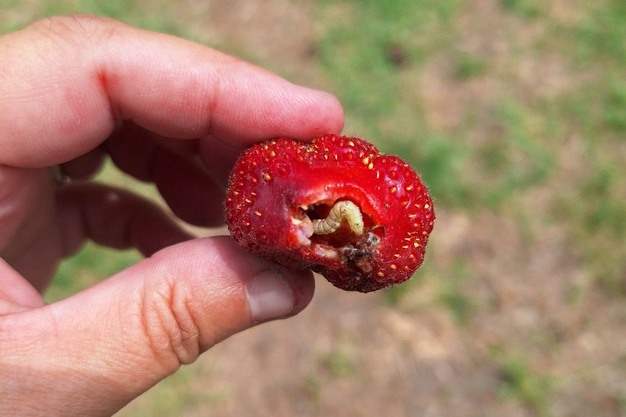The corn earworm (Helicoverpa zea, Lepidoptera: Noctuidae), a significant pest known for its broad host range, has been reported infesting various strawberry fields in North Carolina and Virginia this week. This pest, typically found in corn and tomatoes, can cause extensive damage to strawberries, affecting the fruit quality and yield.
Because the earworms feed directly on the fruit, contact insecticides are not likely to control them. Systemic insecticide options are the best option to remediate these outbreaks, such as Coragen (chlorantraniliprole) or Harvanta (cyclaniliprole). Two insecticide applications scheduled one week apart are enough to mitigate infestation. Some formulations of Bt-based insecticides are approved to control corn earworms in organically-grown strawberries.
 NC State
NC State
The Tarnished plant bug also also known as Lygus bug (Lygus lineolaris, Hemiptera: Lygaeidae, is the eastern US species) has also been reported in various strawberry farms in North Carolina. This pest usually infest strawberries during the last weeks of harvest in early June. However, moderate to severe infestations have been observed 2-3 weeks early this year.
Feeding by nymphs and adults results in distorted, "cat-faced" strawberries due to seed feeding. Lygus bugs start feeding on small growing fruit that limits its normal growth causing deformed ("cat-faced") unmarketable fruit. These insects can be easily seen with the naked eye resting on the plants during the day.
Because Lygus bugs are highly mobile, systemic products are the best option to remediate early outbreaks, such as Transform (sulfoxaflor) or Assail (acetamiprid). These products are highly toxic to bees; thus, read the label closely to keep your pollinators safe and apply them as late as possible in the day to avoid overlaps with the bees' activity peak.
Damaging population outbreaks of corn earworms and Lygus bugs in strawberries are most likely to occur during periods of warmer than usual temperatures. Historical temperature data for NC indicate that maximum temperatures in May fluctuate close to 80°F. However, we reached more than 90°F during the 1st week of May, which may have contributed to the establishment of these pests.
Source: strawberries.ces.ncsu.edu
